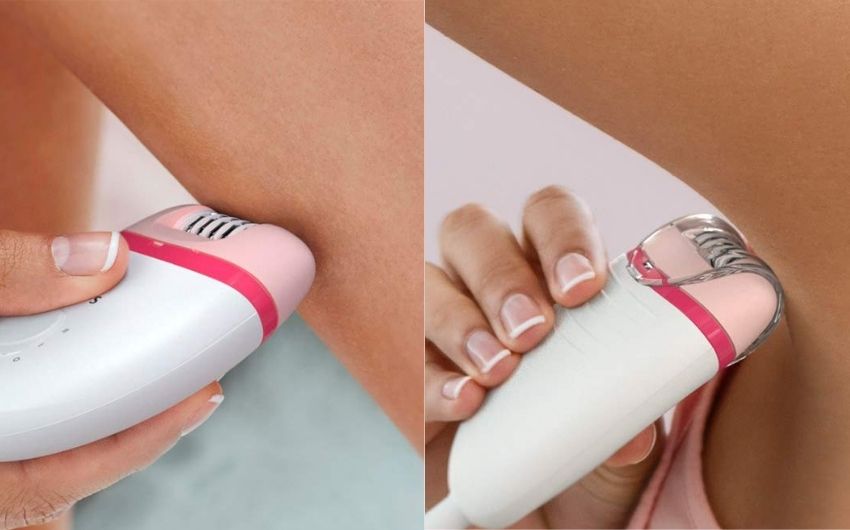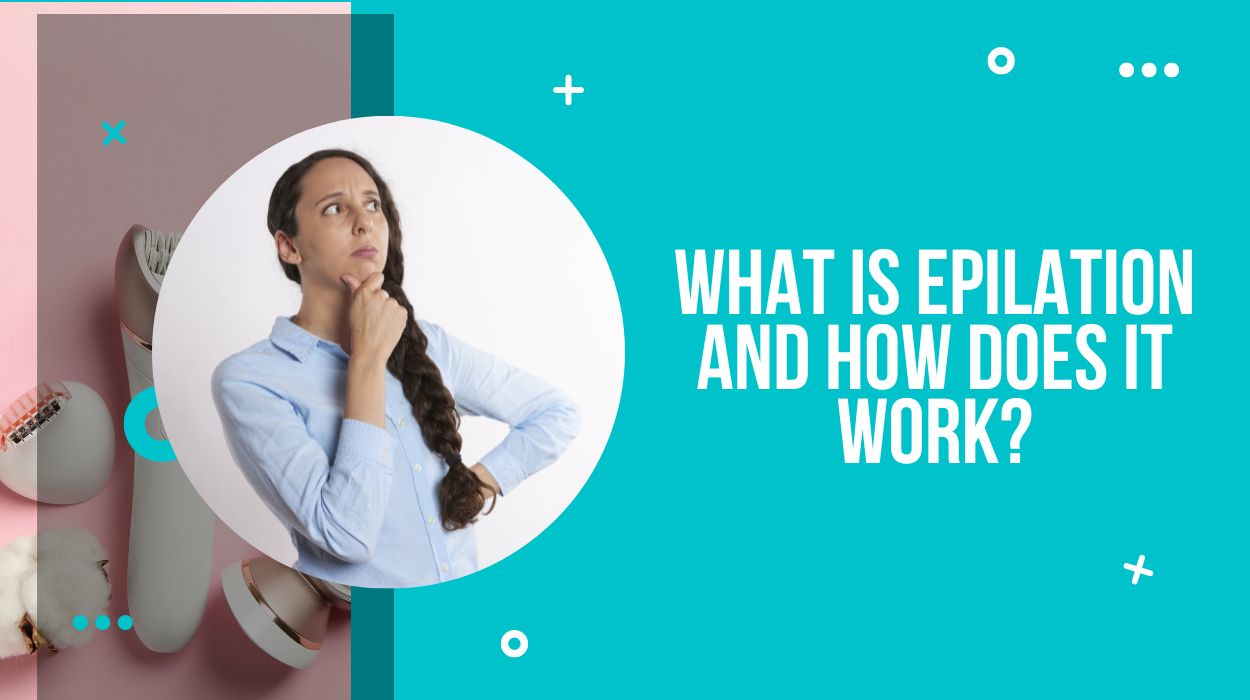Epilators are handheld devices that contain a rotating roller with multiple sets of tweezers. The tweezers remove unwanted hair by placing the roller against your skin and rotating it. Using this method to remove hair can be highly effective and cost-effective anywhere on the body.
The efficacy and long-lasting nature of epilation make it a popular hair removal method. Aside from its ease of use and low operating costs, the method is extremely cheap and easy to implement.
Because of the misinterpretations surrounding epilation, many people are unfamiliar with its advances. This article will explain to you what epilators are, why they’re so great, and why you should try them!
In addition, you need to know that “epilation” refers to any procedure that eliminates hair from below the surface of the skin, not only epilation.
We can also consider waxing as an epilation method. In addition, when we discuss epilation, we are talking about using an epilator device that is handheld and electronic.
How to Use an Epilator?

We stated previously that becoming proficient with an epilator doesn’t take much time, but getting the hang of it will take some time. Do not give up. Initially, you may have accidentally snapped along with the hair rather than extracting them. Using an epilator to its maximum potential can be accomplished by following the following tips.
- Prepare yourself for exfoliation by taking a warm shower. If any lotions or moisturizers are causing your hair to become oily, rinse them off before exfoliating those sections.
- The blades are more likely to clog after using epilators after using any type of product. If you use your epilator dry, thoroughly pat your skin dry afterwards. It won’t be necessary to dry off since we can use some epilators in the shower.
- Especially in places with delicate skin and fleshy areas, stretch your skin taut.
- For best results, place the epilator at 90 degrees against your skin.
- The epilator’s blades should be turned on and moved towards the hair growth direction to use.
- Your hair may rise in several directions at the same time and may change paths a few times, so you may have to go over some areas multiple times to capture all of them.
- You only need to keep the epilator in contact with your skin; do not force it against your skin.
- If you wish to apply any soothing cream or lotion once you have finished, you may do so now. The products that have a strong scent, are oily, or are strong are likely to clog your pores.
- Wearing tight clothing is a bad idea. It is possible to get abrasions and irritations from tight clothes. Avoid exposing your skin to the sun after a few hours since it will be red and sensitive.
- In order to prevent the regrowth of ingrown hairs, gently scrub the area again a few days later.
Epilators: How Do They Work?
Automated, electronic epilation is similar to tweezing but more painless and less invasive. Other types of epilators have been invented since epilators first appeared, but tweezers remain the most popular and effective. Home waxing is now possible without irritation or stickiness, giving you the same smooth skin that you get after waxing.
The rotating movement of the device helps to grab and slickly remove the hair from the follicle, preventing clogs while passing over your skin. Because of the two rotation speeds most epilators have, the slower rotation speed will be perfect for your more sensitive areas.
There are various connections available with epilators. Among the products in this category are skin massagers, delicate area caps, exfoliating brushes, and pedicure foot buffers. You can use the ones with shaving heads on your most sensitive areas, so you will get a full hair removal kit, depending on which one you purchase!
Is the procedure Painful?
The first few times you undergo epilation are going to be painful, but it won’t be as painful as you expect. You will begin to feel less sensation as you continue to epilate. Instead of feeling actual pain, you will experience tingling or stinging. You will also find that the hairs come out more conveniently once you become accustomed to the finer hair.
Choose an epilator that you can use in the shower and bath if you are concerned about how painful it will be. Warm water makes your skin less sensitive, allowing you to relax and open your pores.
It can also be a little less uncomfortable by choosing a slower speed setting, especially for your more sensitive parts, although you will then require more time to complete it.
It is important not to use hot water during epilation, as this can dry out your skin and increase discomfort.
It may even be possible to use your favourite products such as soap or shower gel with the epilator. The rotating action of an epilator makes the product lather on the skin, providing a soothing sensation.
If you are concerned about discomfort, you can epilate your hair growth after a wax. In this way, you’ll experience fewer epilation, as well as your skin adjusting to the sensation.
Epilation vs. waxing: what to prefer?

Epilation is very similar to waxing because they both remove hair by removing follicles, but epilation is generally more effective and convenient. Epilators today can remove hair up to 0.5mm (0.02 inches), versus wax, which can pick up hair to 2mm (0.08 inches). In the first place, an epilator can remove more hair, so you can avoid waiting so long for regrowth.
Epilation is also quicker, and there is no mess, aside from the discarded hair, of course! Getting wax on your skin can leave it sticky and removing the wax streams from between the wax pot or warmer and yourself can be a challenge. You can also easily take your epilator with you since it is a cleaner option. You can pack the appliances precisely into your bag if you need to touch up in the middle of your trip.
Epilation does not remove dead skin cells from the surface of the skin as waxing does. There are no products or heat applied to the skin, so sensitive skin has more advantages since it catches only the hairs in the tweezers.
When taking retinoids (e.g., Accutane) or similar medications, the skin can become more delicate and more prone to tears, so waxing is not recommended; while epilation can be done.
When compared to waxing, epilation offers many benefits. Over time, epilators are significantly more cost-effective, and there is less mess associated with them.
For how long is the smoothness expected to last?
There is no accurate way to estimate how long you can wait between treatments because every person’s hair grows differently. You’re more likely to need epilation if you notice a five o’clock shadow soon after shaving than if you don’t notice the stubble until a week after shaving. Hair growth may slow down over time.
What Causes Regrowth to Be Slower Than Shaving?
Shaving affects only the top layer of hair. In other words, the hair will continually grow unless the follicle is damaged, but it will only be able to grow if it breaks through the skin. Epilated hairs, however, will have to travel up the skin to reach the surface.
A damaged follicle may also hamper the growth cycle, which could cause a delay in growth. When you shave, you see much faster hair regrowth before you need to touch up the epilation again than if you epilate.
When you first epilate, you might notice some regrowth. Don’t let that discourage you. The epilated hairs are at a different stage in their growth cycle than the epilated hairs before, so they weren’t visible and couldn’t be captured. You will find that your hairs will grow less staggered as they align in the growth cycle as you epilate more often.
Does epilation need to be done before or after showering?
With a “Wet and Dry” model that can be used in the shower or bath, you don’t have to decide what to do. The epilator should, however, be used on clean, dry skin as moisturizers and lotions may make the hairs more difficult to achieve.
Water that’s warm also clears your pores, which facilitates the removal of hair. After the hair is removed, the pores remain open, so keeping your skin clean before epilation makes the process more hygienic and reduces the possibility of infection or folliculitis.
Be sure that your skin is completely dry before using an epilator that is corded or “dry only.”
Epilators: What Are the Benefits?
- Smooth Skin that lasts for weeks– it can take weeks for the hair to grow back, and those growing back will likely be sparser and finer when you have only epilated, making them less noticeable.
- No harsh products— Allergy sufferers will appreciate this product because it is gentle on the skin. Since epilation is waste-free, it is eco-friendly as well as removing your unwanted hair!
- Epilation is possible almost everywhere on your body — The skin on some parts of your body is more sensitive than others, but with the proper attachments you can use epilators on other areas of your body such as your face as well, such as these facial epilators.
- The epilator can also be used in the shower– epilators that are designed specifically to be used in the shower reduce discomfort by raising your body temperature and allowing you to enjoy the warm water.
- Short time for hair growth– you don’t have to wait for your hair to grow out in between epilating sessions since modern epilators remove even hair as short as 0.5mm (0.02 inches).
- Very useful — Since some epilators have 72 tweezers, they have a wide pickup range. Besides removing hair that lies flat against your skin, they can also remove hair that is flat on top.
- Cost sufficient– if you buy your epilator, which can cost anywhere between 500 and 3000 rupees depending on its quality, you just have to cover its electricity usage as it consumes so little power.
- Convenience — The device fits easily into your bag, making it easy to carry while travelling, and you won’t be left sticky or burned after epilating. Minimal preparation is needed, and it doesn’t make a mess.
- Flexible to run– You will have no difficulty learning how to epilate, and as you gain confidence, you will be able to speed up your process. Once you get used to epilation, shaving becomes easier than epilation!
Final thoughts
Now that you know how epilators work, what they look like and how they work, you should be able to use one more effectively. Since you do not need long hair to pick up the hairs, epilators are a very convenient and effective way to get rid of unwanted hair.
You may think it is painful to pull out hair from an ingrain or roots. Many people find that epilation is uncomfortable, especially when it’s their first time. You may have sensitive skin in some places. As you epilate more, however, you will feel less pain.



Wow, great article, such a comprehensive guide on how an epilator works but especially on how to use an epilator. I noticed that your pictures feature the latest Philips Bre235 and I wanted to let your readers know that it’s an awesome epilator!